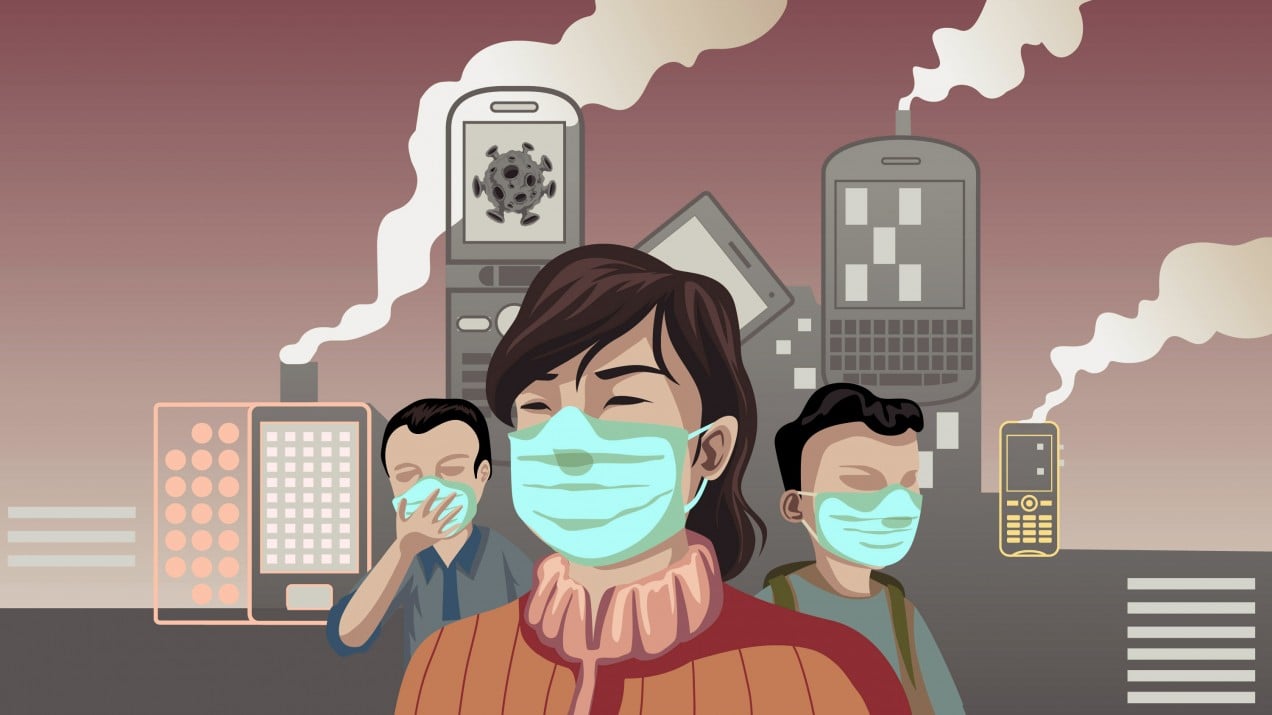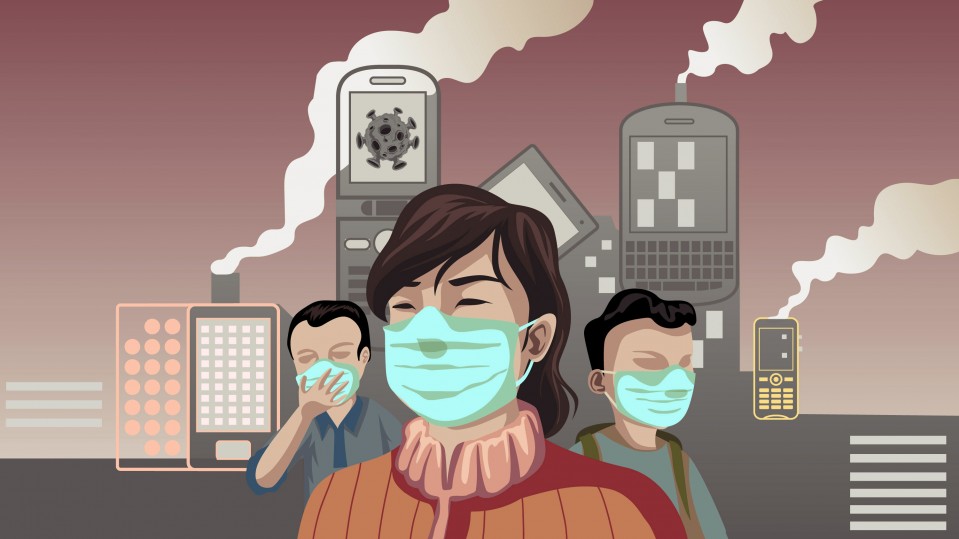

Tech Policy / Tech and Health
The coronavirus is the first true social-media “infodemic”
Social media has zipped information and misinformation around the world at unprecedented speeds, fueling panic, racism … and hope.

On January 19—a week before the Lunar New Year—Tommy Tang left Shenzhen with his girlfriend to visit her family in Wuhan for the holiday. They had heard of the novel coronavirus (now officially known as COVID-19), but as far as they knew, it was localized to a small area. The local government had assured people that it would only affect those who visited a specific food market and contracted it directly from wild animals.
But on the night of the 20th, Dr. Zhong Nanshan—the same doctor who first revealed the extent of SARS in 2003—went on national TV to correct the record. The virus could spread from person to person, he said. Panic ensued. Overnight, everyone in the city began wearing masks. Tang and his girlfriend realized it was no longer safe to stay. They cancelled their plans and left on a train the next day. Less than 48 hours later, the city went into lockdown.
Back in Shenzhen, they placed themselves in a 14-day quarantine, leaving their apartment only once a day, with masks, to take out the trash. Tang, whose family also lives in Shenzhen, couldn’t join them to celebrate the holiday. He wished his mother Happy New Year through his apartment door peephole. He ordered everything from food to soap and toilet paper through delivery apps like Meituan Waimai and Dada-JD Daojia. On the third day of quarantine, Tang went into a panic when he opened the apps to see everything completely sold out.
“There was nothing there—there were zero vegetables,” he says. “But compared to Wuhan, we have it extremely easy,” he adds.
More than anything, the greatest source of anxiety has been the tortuous process of watching the news unfold on social media. It has mirrored and amplified his fears to levels he’s never experienced before. He and his girlfriend have suffered insomnia and multiple panic attacks. They are terrified of contracting the virus and about her family’s well-being.
“Honestly, it’s really hard to describe what happened during these 14 days,” he says. “There’s nothing to do but read the news, and the news gets worse every day. That’s the hardest part for the people outside.”
On February 2, the World Health Organization dubbed the new coronavirus “a massive ‘infodemic,’” referring to ”an overabundance of information—some accurate and some not—that makes it hard for people to find trustworthy sources and reliable guidance when they need it.” It’s a distinction that sets the coronavirus apart from previous viral outbreaks. While SARS, MERS, and Zika all caused global panic, fears around the coronavirus have been especially amplified by social media. It has allowed disinformation to spread and flourish at unprecedented speeds, creating an environment of heightened uncertainty that has fueled anxiety and racism in person and online.
For its part, the WHO has attempted to address the issue by partnering with Twitter, Facebook, Tencent, and TikTok to clamp down on misinformation. It recently launched a Google SOS alert, for example, to push WHO information to the top of people’s search results for coronavirus-related queries. It has also been working with Facebook to target specific populations and demographics with ads that provide important health information. It has even gone so far as to reach out to influencers in Asia to try to keep disinformation at bay.
Social-media and health organizations have also engaged in efforts of their own. TikTok has tried to remove purposely misleading videos, saying in a statement that it would “not permit misinformation that could cause harm to our community or the larger public.” Facebook has also worked to scrub posts with dubious health advice, and Tencent, the owner of WeChat has used its fact-checking platform to scrutinize coronavirus rumors circulating online.
But the sheer avalanche of content has overwhelmed the coordinated efforts to clear out all the noise. This in turn has created a breeding ground for xenophobic content. Racist memes and slurs have proliferated on TikTok and Facebook. Some teens have even gone about faking a coronavirus diagnosis to earn themselves more social-media clout. This online toxicity has also translated into in-person interactions. Asians have faced outright racism and harassment, and Chinatowns and Chinese restaurants have seen business lag.
Similar levels of discrimination have been reported (link in Chinese) in China against people from Wuhan and the larger Hubei province. In some cases, those who are stranded because they were traveling during the lockdown are being denied hotel rooms once their national IDs reveal their hometowns.
But as much as social media has perpetuated disinformation, it has been an important source of verified information as well. Journalists around the world have used Chinese social media to gain a more accurate picture of the situation and gathered and archived (link in Chinese) verified reports for posterity. The volume of personal anecdotes and reports that circulate every day about the ground truth in China has also pressured the government to release more accurate information about the crisis.
In the early days, for example, several doctors took to social media to raise alarms about the severity of the situation. Though the government swiftly reprimanded them and moved to control the flow of information, their warnings went viral, likely accelerating the government to be more forthcoming about the reality. Later, when one of the doctors, Li Wenliang died from the sickness, Chinese platforms lit up with an outpouring of anguish and rage, questioning the government’s decision and authority. The discontent was so pervasive that it thwarted censors.
Such social-media activity could also be mined in the future to catch and track future disease outbreaks. Several services are already using these techniques to help public health officials monitor the coronavirus’s progression. Raina MacIntyre, a biosecurity expert at the University of New South Wales, published an article in January in the journal Epidemiology that found that hot spots of tweets could be good indicators of how a disease spreads. “Especially where there is censorship or lack of resources for disease reporting,” she says, this could help organizations react even earlier during a viral outbreak, stopping them before they become global health emergencies.
In a strange way, social media has also become a space for collective grieving. On Weibo and WeChat, stories of despair and kindness abound. Alongside expressions of fear from people stuck in quarantine and from patients unable to receive treatment are also anecdotes of people donating (link in Chinese), volunteering, and helping one another in unexpected and generous ways.
“Those personal stories—you don’t read them a lot in international coverage of the outbreak,” says Shen Lu, a journalist based in Boston who has been following Chinese social-media activity around the coronavirus closely. But they have become an important way for people to follow the crisis both within and outside China, serving as a form of catharsis and giving people, amid all the panic and toxicity, a small ray of hope.